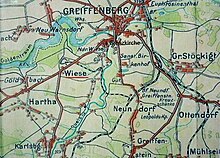Wieża (Gryfów Śląski)
Wieża (German Wiesa ) is a village in the rural community Gryfów Śląski (Greiffenberg) in the powiat Lwówecki in the Lower Silesian Voivodeship in Poland. The scattered settlement, consisting of Niederwiesa ("Nieder Wiesa", also "Niederwiese") and Oberwiesa ("Ober Wiesa"), lies at an altitude of 315 to 330 m on the left bank of the Queis across from Gryfów Śląski. In the years 1975 to 1998 the place belonged to the Jelenia Góra Voivodeship .
Surname
In the chronicle Liber fundationis episcopatus Vratislaviensis (tithe register of the diocese of Breslau ), written from 1295 to 1305 under Prince-Bishop Heinrich von Würben († 1319), the place is mentioned in the Latinized form as "Wes".
history
The village, which is historically located in Upper Lusatia on the former Silesian-Saxon border, was founded by German settlers, probably in the second half of the 13th century. The oldest document that mentions the name comes from 1294, according to other sources from 1346. For a long time the village belonged to the Czocha Castle and was under the rule of the von Nostitz and von Uechtritz families . In 1497 the place was ravaged by the plague.
Until 1815 Wiesa belonged to the Queiskreis in Upper Lusatia, which is part of the Electorate of Saxony. Due to its border location, the place played an important role in the 17th and 18th centuries. First a Protestant church ( refuge church ) for the persecuted Protestants in Silesia was built in the upper district of Ober Wiesa . In 1669 a second Protestant church ( border church ) was built in the lower district of Nieder Wiesa (directly on the border with the Silesian principality of Jauer ) , which was mainly used by the residents of the neighboring town of Greiffenberg. Since 1816 the place belonged to the Lauban district in Prussian Upper Lusatia. In 1937 Wiesa was renamed Wiese (Lower Silesia).
The place has belonged to Poland since 1945. On May 8, 1946, the church in Ober Wiesa was destroyed by fire, and in 1949 the church in Nieder Wiesa too. The remains of the church ruins were removed in the 1970s. A lapidarium was built next to the location of the old church of Nieder Wiesa , reminding of the two former Protestant churches in the village. According to Mr. Bogacki, one of the old bells from Nieder Wiesa now hangs in the tower of the Church of the Resurrection in Bamberg .
Pastors of the church in Nieder Wiesa
Pastors at the church in Nieder Wiesa were:
- Caspar Tornau , first pastor of the church
- Johann Christoph Schwedler (1672–1730)
- Johann Christoph Tschanter (1683–1738)
- Christoph Adolph (1639-1698), whose son Gottlob Adolph (1685-1745) pastor at the Church of Grace to Hirschberg was
- Samuel Gottfried Weissig (born June 8, 1755 in Hirschberg, † March 31, 1816 in Nieder Wiesa)
- Heyn from 1934 to 1944 - last German pastor in Wiesa
Personalities in the place
- Eugenio Casparini (actually Eugen Johann Caspar) (1623–1706), worked as an organ builder in Italy, Tyrol and Vienna, spent the last years of his life in Wiesa and died here in 1706. He was the builder of the first solar organ in the parish church of St. Peter and Paul in Görlitz, which no longer exists today.
- Carl Börner (1828–1905), sculptor, born in Niederwiesa
economy
The place is characterized by agriculture. Until 1945 there was a basalt quarry of the "Silesian Basalt Works in Wiesa bei Greiffenberg" on the road to Goldbach (Złoty Potok) .
Attractions
- The former rectory from 1780, rebuilt at the beginning of the 20th century, today a residential building, is listed as a cultural monument in the register of the Polish National Cultural Heritage Institute.
- In the vicinity of the rectory, approximately opposite the location of the old church, there is a lapidarium, newly built in 2014 by the local residents, with fragments of gravestones and epitaphs from the old pastors' cemetery.
Web links
- Kurt-Michael Beckert: Heimatarchiv Lauban - Wiesa with pictures from the old village (accessed on April 15, 2016)
Individual evidence
- ↑ At that time, Upper Lusatia was still part of the Electorate of Saxony.
- ↑ rural municipality and city Gryfow Slaski, OT Wieża (accessed on 15 April 2016)
- ↑ Michael Sachs: The flight of the evangelical wife Anna Magdalena von Reibnitz (1664– ~ 1745) with her five children from Silesia, threatened by forced Catholicization, in 1703 - a mood picture from the age of the Counter Reformation and Pietism. In: Medical historical messages. Journal for the history of science and specialist prose research. Volume 34, 2015 (2016), pp. 221–263, here: p. 241, note 55.
- ↑ Kurt-Michael Beckert: Heimatarchiv Lauban - Wiesa (accessed on April 15, 2016)
- ↑ Portrait of Pastor Tschanter (accessed on April 15, 2016)
- ↑ WikiTree with picture by Weissig (accessed April 15, 2016)
- ↑ Jarosław Bogacki: Texts and text fates in the eventful Reformation times. On the linguistic interest in texts by Greiffenberg pastor Wolfgang Silbers the Younger (1569 - 1639). In: Slovak magazine for German studies. Volume 8, 2016, Issue 2, pp. 46–60, or at sung.sk/fotky10204/SZfG/2016_2/46_SZfG_2016_2.pdf (accessed on March 15, 2019)




